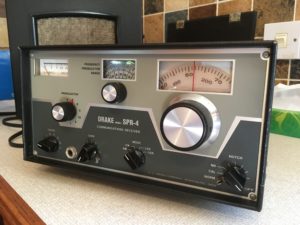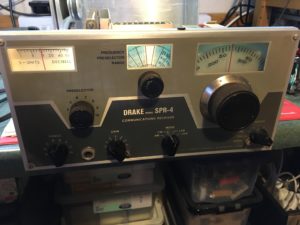This little receiver is another one of my absolute favourites of all time. It may not be the ultimate ‘do everything’ radio, but it really does its job rather well. Here’s the official description:
The R.L. Drake Company produced the solid-state SPR-4 receiver with the serious shortwave listener in mind. Supplied coverage includes: 0.15-.5, .5-1.5, 6-6.5, 7-7.5, 9.5-10, 11.5-12, 15-15.5, 17.5-18 and 21.5-22 MHz. Additional 500 kHz crystal ranges are available. A total of 23 ranges may be employed. Modes of reception include: AM, SSB (LSB/USB) and RTTY (with optional RTTY adapter).
The dial accuracy is ± 1 kHz when calibrated to the nearest 100 kHz calibration point. Other features include: S-Meter, IF Notch, Preselector, RF Gain, Mute, Dial Lamp, Dial Lamp Switch, Spinner Knob, Audio In-Out Jack, Anti-Vox Jack. The antenna input is an RCA phono jack. This radio has a speaker built into the left side panel. 10.75 x 5.5 x 12.25 inches 18 lbs. Operation is from 120 VAC or 240 VAC switch selectable from the rear panel.
From what I can find on-line, the SPR-4 was first released in 1969, and a revised version in 1972 or thereabouts. You can easily tell the difference between the two as the later version has a finger spinner on the main tuning knob, whereas the original one does not. Twenty years ago I had the later version complete with all options, crystals and the AL-4 loop. In a moment of madness I sold it.
In mid 2021 I got the chance of another, but this time the earlier version. It didn’t work and the spun aluminium discs were missing from the front of the knobs. Fortunately most of the crystals had been installed so I had all the regular short wave bands and amateur bands. I think the marine ones may be missing.
The covers were removed and the radio carefully cleaned. Once powered up I discovered that a rather pure silence was emanating from the speaker. A few checks revealed the receiver was permanently muted. This was traced to Q26, a 2N4125 PNP transistor, on the power supply board. Here are three links to the circuit diagram, power supply board layout and an image of the actual board. It’s a bit of a hard one to get at, but once it was changed the receiver burst into life.
There are many fantastic reviews of the Drake SPR-4 on eHam but I’d suggest you try and find one for yourself. They are a joy to use, the filtering is excellent as is the audio quality. The notch filter works very well and there are several accessories available if you can find them. The MS-4 speaker matches this receiver, as it does the Drake C-Line, there is an AL-4 loop which plugs into the top and Drake made an FS-4 frequency synthesiser which gives you all of the crystal ranges without buying the crystals. I found that I could here things on this receiver that most others, costing many times more, could not.
When buying, watch out for problematic tuning drives, as they are plastic and can become worn if not looked after. I believe there are a couple of projects on the internet to allow you to provide the same functionality of the FS-4, using modern techniques.

